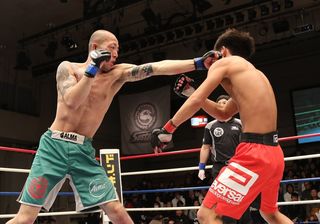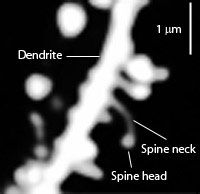
Traumatic Brain Injury
It Ain't About How Hard You Hit
What is going on in the brain when a fighter gets punched or kicked in the head?
Posted November 30, 2017
Have you ever hit your head so hard that you felt your brain bouncing inside your skull, or sensed the world spinning around you as though you were drunk?
This is how Shannon Gugerty, a professional MMA (Mixed Martial Arts) fighter, describes his experience with traumatic brain injuries (TBI).
Shannon has been involved in combat sports for a long time, as an amateur and later, as a professional fighter (including part of his career in UFC). His first professional fight happened in 2004. He won. After that, Shannon won all of his fights until during one of his training sessions, he was kicked in the neck and got "rocked" (slang referring that feeling of dizziness and loss of coordination without really getting knocked out). What happened to Shannon that day was probably his very first concussion, although it was not as bad as the ones that came years later.

A ping-pong ball inside the skull
I have been practicing Muay Thai for almost three years now. As soon as my sparring partners find out I am a neuroscientist, the most common question I get asked is what happens to our brains when we get punched in the head and, worst case scenario, knocked out (loss of consciousness). When your head gets banged, what you are experiencing is a traumatic brain Injury (TBI). Depending on the nature of the bang, it can be considered acute or chronic (a.k.a. chronic traumatic encephalopathy—CTE—originally called dementia pugilistica).
An acute TBI, in contact sports such as Muay Thai or MMA, is the result of a precise punch or kick to your head and will leave you unable to continue fighting. Sometimes, TBI involves loss of consciousness due to a momentary drop in the blood flow to the brain because of the heavy, violent hit. Rapid acceleration and deceleration forces (the punch or the kick) on the head and jaw transmit to the brain and cause the stretch of its components (neurons, glial cells, and blood vessels). It may cause a concussion, a hemorrhage or another kind of structural damage like skull fracture or edema (swelling of the brain). At the cellular level, there is an accumulation of “unwanted” molecules and substantial electrical change in the neurons resulting in the reduction of neuronal energy and axons being pulled apart, all leading to neuronal death. These injuries do not just happen in combat sports; in recent years, many injuries have been reported among American football players.
After getting rocked, Shannon was done training that day but he was back on track the week after, sparring again. He now regrets that decision and reckons that he should have rested for longer than merely a week. He is right. After a symptomatic concussion, like the one Shannon experienced, 24 to 48 hours of rest are recommended, and it takes about 7 to 10 days to fully recover from an acute concussion. However, magnetic resonance, electrophysiology, and psychological studies suggest that concussed fighters need at least 30 to 45 days to get their brain back to normal.
After that first TBI, Shannon got by for a good couple of years without ever getting knocked out or even rocked again. He signed a contract with UFC and won 10 fights in a row. It was at that time when, once again while training, he got the hardest hit that he remembers. A punch right to his head made him hear a loud buzzing noise inside his head, and his brain “felt like a ping-pong ball inside the skull, bouncing,” as he describes it. But he kept going, and the trouble came a bit later when he was home laying down and his head started spinning as if he had drunk too much: "I was throwing up and totally out of balance.” He describes quite accurately some of the symptoms that you expect from a concussion like dizziness, nausea and mental confusion. On both occasions, Shannon did not get medical attention and was back training the week after.
Shannon’s last professional fight ended up with him in the hospital for a CT scan. The punch his opponent threw in the third round of the fight caused nonstop vomiting and an intense headache once the fight was over, but medical tests came up clean. Yet two days later, he was suffering from a terrible depression. He recalls getting long, lingering headaches in response to any little hit in the head. In view of the situation, Shannon decided to quit professional fighting before things could get worse. Now he coaches Jiu-Jitsu, a combat sport that involves a lower risk of hits in the head.
CTE (quite common in long-term injuries among boxers) consists of a build-up of injuries that, although not sudden and fatal, will eventually cause some degree of damage to the brain. It depends on the number of injuries that one accumulates and even some genetic predisposition that makes one more vulnerable. Therefore, the longer you are exposed to hits in your head, the more chances you have to develop CTE. CTE can show up years after retiring from the sport and its hallmark is an unusual accumulation of tau protein, the same protein involved in Alzheimer’s disease (check out this slideshow by the Alzheimer’s Association). This does not mean that if you practice a combat sport, you will definitely suffer from Alzheimer’s disease. Tau protein accumulation occurs mainly around the area of the injury and levels of the protein usually come back to normal after a few weeks of recovery. CTE is divided into four different stages, stage IV being the one where the structural changes in the brain (reduction of the brain weight, aggregation of tau protein) and clinical symptoms (loss of memory, irritability, headaches, depression) are more prominent.
Quantity over quality (of the hit)
“It ain’t about how hard you hit. It’s about how hard you can get hit and keep moving forward.” Rocky Balboa's boxing analogy may be an apt description of life in general, but it's not an ideal way to think about brain injury in combat sports.
A recent and interesting study on mice showed that repeated TBI (with loss of consciousness i.e., mice were actually knocked out) over long periods of time resulted in progressive brain damage that remains for at least a year after. Mice that received a single TBI spontaneously recovered without much problem within three days of rest.

TBI may cause loss of spines. Neurons transfer information through synapses. The synaptic machinery is located in spines, protrusions on the neuronal dendrites - the neuron "branches". Spine loss might represent an adaptive and protective neuronal strategy.
Additionally, the study showed that a single TBI caused loss of spines (the protrusions in the dendrites of neurons that make communication with the pre-synaptic neuron possible), regardless of the severity of the impact. The same phenomenon was observed in response to repeated TBIs when the interval between the hits was at least seven days, giving the mice enough time to recover between TBIs. However, when repeated TBIs were inflicted without a resting period in between injuries, spine loss did not happen, probably due to the neurons habituating to the TBI. Spine loss could be an adaptive and protective strategy for the neurons in order to avoid worse consequences (like an excessive influx of calcium that could trigger cell death mechanisms), something that has been hypothesized for other disorders like stroke.
In short, repeated TBIs may contribute to lasting brain damage. So, it ain’t about “how hard you can get hit,” as Rocky said, but about how many times you get hit and the time of recovery between hits, at least regarding permanent damage in your brain. Hence the importance that the injured fighter does not expose her/himself to new TBIs before total recovery.
Despite the risks that combat sports such as Muay Thai or MMA entail, my intention is far from scaring anyone off from trying any of these sports. Advances in research and medicine have made the prognosis, diagnosis and treatment of TBI and CTE much more effective than years ago. The risks are minimum at beginner’s level and even at amateur level, at which the protective gear makes harder to get bad brain injuries. Plus, the benefits are enormous at many different levels, improving your fitness, confidence, and stamina. There is no more risk in practicing these sports than any other physical activity.
I would like to thank Shannon Gugerty to take the time to talk to me and share his story.
This post was originally published in NeuWrite San Diego.
References
The Neuropathology of Sport, Ann C. McKee, Daniel H. Daneshvar, Victor E. Alvarez, Thor D. Stein (2014). Acta Neuropathol 127:29–51.
Metabolic and Cognitive Response to Human Traumatic Brain Injury: A Quantitative Proton Magnetic Resonance Study William M. Brooks, Christine A. Stidley, Helen Petropoulos, Rex E. Jung, David C. Weers, Seth D. Friedman, Matthew A. Barlow, Wilmer L. Sibbitt, Jr. And Ronald A. Yeo Journal Of Neurotrauma Volume 17, Number 8 (2000).
Cumulative effects of concussion in amateur athletes. Grant L. Iverson, Michael Gaetz, Mark R. Lovell & Michael W. Collins (2004) Brain Injury, 18:5, 433-443.
Apolipoprotein E ∈4 Associated With Chronic Traumatic Brain Injury in Boxing. Jordan BD, Relkin NR, Ravdin LD, Jacobs AR, Bennett A, Gandy S. JAMA. 1997;278(2):136-140.
CSF-Biomarkers in Olympic Boxing: Diagnosis and Effects of Repetitive Head Trauma Neselius S, Brisby H, Theodorsson A, Blennow K, Zetterberg H, et al. CSF-Biomarkers in Olympic Boxing: Diagnosis and Effects of Repetitive Head Trauma. (2012) PLoS ONE 7(4).
Dendritic Spine Loss and Chronic White Matter Inflammation in a Mouse Model of Highly Repetitive Head Trauma. Charisse N. Winston, Anastasia Noël, Aidan Neustadtl, Maia Parsadanian, David J. Barton, Deepa Chellappa, Tiffany E. Wilkins, Andrew D. Alikhani, David N. Zapple, Sonia Villapol, Emmanuel Planel, and Mark P. Burns, The American Journal of Pathology, The American Journal of Pathology, Vol. 186, No. 3, March 2016



